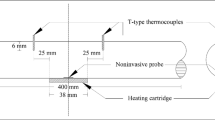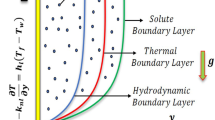Abstract
In this paper, two-phase Nanofluid condensation and heat transfer analysis over a vertical plate under gravity and between two parallel plates under magnetic force are investigated respectively using Least Square Method (LSM) and numerical method. After presenting the governing equations and solving them by LSM, the accuracy of results is examined by fourth order Runge–Kutta numerical method. Modeling results show that the condensate film thickness after condensation is reduced and therefore, the rate of heat transfer is enhanced by the addition of nanoparticles to the regular fluid. Effect of different nanoparticles and constant numbers on the temperature/velocity/concentration profiles as well as Nusselt number and boundary layer thickness, are also investigated. For instance, it was found that TiO2 and Ag have maximum boundary layer thicknesses and Nusselt number, respectively. By considering the magnetic field effect, it is also found that nanoparticles concentration can be controlled by changing the Hartmann number which, in turn, leads to different condensation and heat transfer properties.











Similar content being viewed by others
Abbreviations
- \(A\) :
-
Ratio of thermophoretic effects to Brownian diffusion effects of nanofluid
- \(C\) :
-
Concentration of nanofluid
- \(C_{p}\) :
-
Specific heat
- \(D_{T} ,\,D_{B}\) :
- \(F\left( \varphi \right)\) :
-
Function of nanoparticle volume fraction
- \(g\) :
-
Gravity acceleration
- \(k\) :
-
Thermal conductivity
- \(k_{nf}\) :
-
Thermal conductivity of nanofluid
- \(k_{f}\) :
-
Thermal conductivity of pure fluid
- \(k_{s}\) :
-
Thermal conductivity of nanoparticle
- \(kr\) :
-
Rotation parameter
- \(M\) :
-
Magnetic parameter
- \(Nb\) :
-
Brownian motion parameter
- \(Nt\) :
-
Thermophoresis parameter
- \(Nu\) :
-
Nusselt number
- P :
-
Pressure
- Pr:
-
Prandtl number
- \(\delta\) :
-
Condensate film thickness
- \(\varphi\) :
-
Nanoparticle volume fraction
- \(\eta ,\,\xi\) :
-
Dimensionless distance
- \(\mu_{nf}\) :
-
Viscosity of nanofluid
- \(\theta\) :
-
Dimensionless temperature
- \(\rho\) :
-
Density
- \(\rho_{nf}\) :
-
Density of nanofluid
- \(\rho_{f}\) :
-
Density of pure fluid
- \(\rho_{s}\) :
-
Density of nanoparticle
References
Kakaç S, Pramuanjaroenkij A (2009) Review of convective heat transfer enhancement with nanofluids. Int J Heat Mass Transf 52:3187–3196
Mahmood M, Asghar S, Hossain MA (2007) Squeezed flow and heat transfer over a porous surface for viscous fluid. Heat Mass Transf 44:165–173
Abd-El Aziz M (2010) Unsteady fluid and heat flow induced by a stretching sheet with mass transfer and chemical reaction. Chem Eng Commun 197:1261–1272
Domairry G, Aziz A (2009) Approximate analysis of MHD squeeze flow between two parallel disks with suction or injection by homotopy perturbation method. Math Probl Eng 2009:603916
Mustafa M, Hayat T, Obaidat S (2012) On heat and mass transfer in the unsteady squeezing flow between parallel plates. Meccanica 47:1581–1589. doi:10.1007/s11012-012-9536-3
Turkyilmazoglu M (2015) Analytical solutions of single and multi-phase models for the condensation of nanofluid film flow and heat transfer. Eur J Mech B/Fluids 53:272–277
Hatami M, Domairry G (2014) Transient vertically motion of a soluble particle in a Newtonian fluid media. Powder Technol 253:481–485
Hatami M, Ganji DD (2014) Motion of a spherical particle on a rotating parabola using Lagrangian and high accuracy multi-step differential transformation method. Powder Technol 258:94–98
Hatami M, Ganji DD (2014) Motion of a spherical particle in a fluid forced vortex by DQM and DTM. Particuology 16:206–212
Dogonchi AS, Hatami M, Domairry G (2015) Motion analysis of a spherical solid particle in plane Couette Newtonian fluid flow. Powder Technol 274:186–192
Haghshenas M, Fard M, Esfahany N, Talaie MR (2010) Numerical study of convective heat transfer of nanofluids in a circular tube two-phase model versus single-phase model. Int Commun Heat Mass Transfer 37:91–97
Göktepe S, Atalık K, Ertürk H (2014) Comparison of single and two-phase models for nanofluid convection at the entrance of a uniformly heated tube. Int J Therm Sci 80:83–92
Mohyud-Din ST, Zaidi ZA, Khan U, Ahmed N (2015) On heat and mass transfer analysis for the flow of a nanofluid between rotating parallel plates. Aerosp Sci Technol 46:514–522
Hayat T, Imtiaz M, Alsaedi A, Kutbi MA (2015) MHD three-dimensional flow of nanofluid with velocity slip and nonlinear thermal radiation. J Magn Magn Mater 396:31–37
Khan JA, Mustafa M, Hayat T, Alsaedi A (2015) Three-dimensional flow of nanofluid over a non-linearly stretching sheet: an application to solar energy. Int J Heat Mass Transf 86:158–164
Hatami M, Ganji DD (2014) Natural convection of sodium alginate (SA) non-Newtonian nanofluid flow between two vertical flat plates by analytical and numerical methods. Case Stud Therm Eng 2:14–22
Fakour M, Vahabzadeh A, Ganji DD, Hatami M (2015) Analytical study of micropolar fluid flow and heat transfer in a channel with permeable walls. J Mol Liq 204:198–204
Ghasemi SE, Hatami M, Sarokolaie AK, Ganji DD (2015) Study on blood flow containing nanoparticles through porous arteries in presence of magnetic field using analytical methods. Phys E 70:146–156
Ghasemi SE, Hatami M, Mehdizadeh Ahangar GHR, Ganji DD (2014) Electrohydrodynamic flow analysis in a circular cylindrical conduit using least square method. J Electrostat 72(1):47–52
Rahimi-Gorji M, Pourmehran O, Hatami M, Ganji DD (2015) Statistical optimization of microchannel heat sink (MCHS) geometry cooled by different nanofluids using RSM analysis. Eur Phys J Plus 130:22
Domairry G, Hatami M (2014) Squeezing Cu–water nanofluid flow analysis between parallel plates by DTM-Padé Method. J Mol Liq 193:37–44
Ahmadi AR, Zahmatkesh A, Hatami M, Ganji DD (2014) A comprehensive analysis of the flow and heat transfer for a nanofluid over an unsteady stretching flat plate. Powder Technol 258:125–133
Ozisik MN (1993) Heat conduction, 2nd edn. Wiley, London
Stern RH, Rasmussen H (1996) Left ventricular ejection: model solution by collocation, an approximate analytical method. Comput Boil Med 26:255–261
Vaferi B, Salimi V, Dehghan Baniani D, Jahanmiri A, Khedri S (2012) Prediction of transient pressure response in the petroleum reservoirs using orthogonal collocation. J Petrol Sci Eng 98/99:156–163
Hatami M, Ganji DD (2014) Thermal behavior of longitudinal convective–radiative porous fins with different section shapes and ceramic materials (SiC and Si3N4). Ceram Int 40(5):6765–6775
Hatami M, Ganji DD (2014) Investigation of refrigeration efficiency for fully wet circular porous fins with variable sections by combined heat and mass transfer analysis. Int J Refrig 40:140–151
Hatami M, Mehdizadeh Ahangar GHR, Ganji DD, Boubaker K (2014) Refrigeration efficiency analysis for fully wet semi-spherical porous fins. Energy Conver Manag 84:533–540
Ghasemi SE, Valipour P, Hatami M, Ganji DD (2014) Heat transfer study on solid and porous convective fins with temperature-dependent heat generation using efficient analytical method. J Cent South Univ 21(12):4592–4598
Gao SQ, Duan HY (2008) Negative norm least-squares methods for the incompressible magneto-hydrodynamic equations. Act Math Sci 28B(3):675–684
Ghasemi SE, Hatami M, Ganji DD (2014) Thermal analysis of convective fin with temperature-dependent thermal conductivity and heat generation. Case Stud Therm Eng 4:1–8
Aziz A (2006) Heat conduction with Maple. RT Edwards, Philadelphia
Hatami M, Cuijpers MCM, Boot MD (2015) Experimental optimization of the vanes geometry for a variable geometry turbocharger (VGT) using a design of experiment (DoE) approach. Energy Convers Manag 106:1057–1070
Song DX, Jing DW, Geng JF, Ren YX (2015) A modified aggregation based model for the accurate prediction of particle distribution and viscosity in magnetic nanofluids. Powder Technol 283:561–569
Song DX, Jing DW, Luo B, Geng JF, Ren YX (2015) Modeling of anisotropic flow and thermodynamic properties of magnetic nanofluids induced by external magnetic field with varied imposing directions. J Appl Phys 118:045101
Acknowledgements
The authors gratefully acknowledge the financial support of the National Natural Science Foundation of China (Nos. 51422604, 21276206) and the National 863 Program of China (No. 2013AA050402). This work was also supported by the China Fundamental Research Funds for the Central Universities.
Author information
Authors and Affiliations
Corresponding author
Rights and permissions
About this article
Cite this article
Hatami, M., Mosayebidorcheh, S. & Jing, D. Two-phase nanofluid condensation and heat transfer modeling using least square method (LSM) for industrial applications. Heat Mass Transfer 53, 2061–2072 (2017). https://doi.org/10.1007/s00231-016-1964-5
Received:
Accepted:
Published:
Issue Date:
DOI: https://doi.org/10.1007/s00231-016-1964-5




